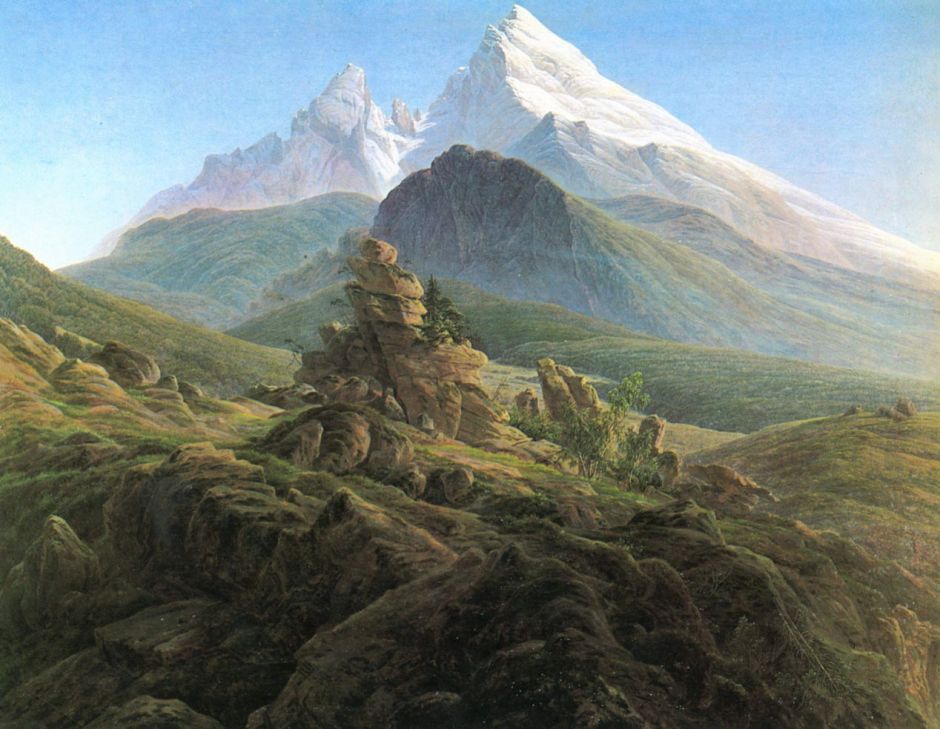As we reach the end of this series, this article gathers together a small selection of views of the European Alps that never made it to earlier articles.
Once the Napoleonic Wars had ended, British artists were able to travel more freely through Europe. Among them was JMW Turner, who visited the Alps from 1802 onwards, often when he was on his way to Venice.

Turner’s Tell’s Chapel, Lake Lucerne, a watercolour from 1841, shows a commemorative chapel to the Swiss hero William Tell. This allegedly marks the spot where Tell leapt from a boat in which he was being held captive. He escaped to kill the tyrant Gessler, and so to lead the rebellion that brought the precursor of modern Switzerland. The chapel shown here was replaced in 1879 by one decorated with frescos painted by Ernst Stückelberg from Basel. This location is at the foot of the Axenberg cliffs, which in turn rise to the ridge of Glärnisch at 1,022 metres (3,353 feet).

Turner’s favourite mountain was Mount Rigi, also known as the Queen of the Mountains, which is almost surrounded by lakes and rises to the peak of Rigi Kulm at 1,798 metres (5,897 feet). Among his many late watercolours of the Rigi is this famous view across Lake Lucerne, The Blue Rigi, Sunrise from 1842. The mountain is blue in the early dawn, and the planet Venus shimmers vertically above its peak. The foreground features forms suggesting dogs chasing wildfowl at the shore, and at the right the small lights of fishing boats.

The influential critic and vocal supporter of Turner, John Ruskin, was a keen amateur painter in watercolours and a fine draftsman. His watercolours such as this Fragment of the Alps from 1854-56 were strongly influenced by Turner, and appear to follow the precepts he laid down in his authoritative series Modern Painters.

Ruskin drew The Aiguille Blaitière in about 1856. More correctly named the Aiguille de Blaitière, this rugged series of peaks is in the Mont Blanc Massif, and reaches 3,522 metres (11,555 feet). At the time, it hadn’t been climbed successfully, an achievement of ER Whitwell with the Lauener brothers as his guides, in 1874.
During the summer of 1856, several British painters were at work in the Alps, most trying to follow Ruskin’s precepts from the fourth volume of his Modern Painters series. John Brett ascended to the glacier above the village of Rosenlaui, where he painted his first real landscape work, about ten kilometres (six miles) from where John William Inchbold was at work.

Brett’s Glacier of Rosenlaui (1856) is an extraordinarily accomplished initial landscape painting. It follows Ruskin’s demanding precepts: much of it appears to have been painted in front of the motif, and it’s rendered in fine detail, even though the artist signed and dated it 23 August 1856. Brett also painted a few impressive watercolours before returning to England. In December, this painting impressed Dante Gabriel Rossetti and William Holman Hunt, and even received praise from Ruskin himself, but didn’t sell.
In the summer of 1858, Brett set off again to the Alps, where he ended up painting a second remarkable mountain view, this time at Val d’Aosta in north-west Italy.

Val d’Aosta (1858) was painted from a hill about a kilometre north-east of where Brett was lodging, according to Christopher Newall. In contrast to Glacier of Rosenlaui, Brett augments the geological details in the foreground with a sleeping woman and a brilliant white goat. Surprisingly, it omits the fortress of Châtel Argent and the Château de Saint-Pierre, although those appear in sketches that Brett made at the time. The only buildings shown are smaller, more rustic farms and dwellings, set in finely detailed orchards, vineyards, and pastures.
After starting with a series of studies and sketches, Brett seems to have worked on the oil version in front of the motif, then brought it back to England for completion during the late autumn of that year. He considered it finished by Christmas, and it was exhibited at the Royal Academy in 1859. Ruskin’s remarks were uncommitted, and the painting didn’t even have an offer made for it.
John Brett abandoned painting mountains, and flourished later with the exact opposite, seascapes, mostly of the English Channel and its coastline.
My last artist started his working life as a scenery painter, before moving on from the backstage of the Vienna Opera to become a pioneer fantasy artist. Along the way he painted some fine views of the Alps.

His undated View of Ramsau near Berchtesgaden shows this rural village in the German Bavarian Alps, with the looming massif of the Watzmann in the far distance. This bears a series of three peaks, the highest of which is 2,713 metres (8,901 feet), making it the third highest in Germany. It had earlier been painted by Caspar David Friedrich, shown below.


Janny also crossed the Alps to paint views of the Dolomites, including this watercolour of The Sella Group and Lake Pisciadu which he made in 1916, half way through the First World War. The Sella Group is a plateau-like massif with Piz Boè at 3,151 metres (10,338 feet).

Another of Janny’s undated watercolours shows The Wilde Kaiser at Kufstein in the Austrian Tyrol, over the other side of the border from Berchtesgaden. The Kaiser Mountains form the backbone of this part of Austria. The rugged limestone ridge seen here is known as the ‘wild’ Kaiser, in contrast to the ‘tame’ Kaiser with its pine trees, and rises to the peak of Ellmauer Halt at 2,344 metres (7,690 feet).

